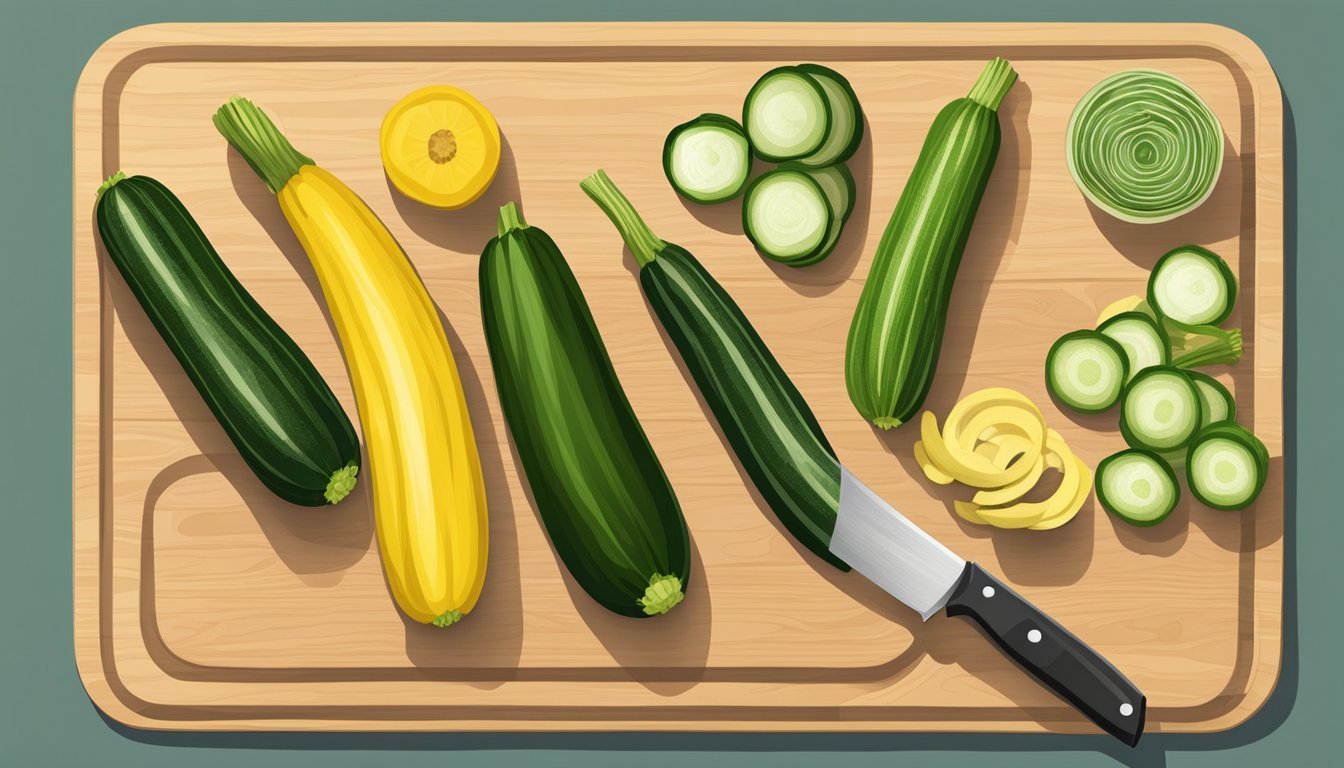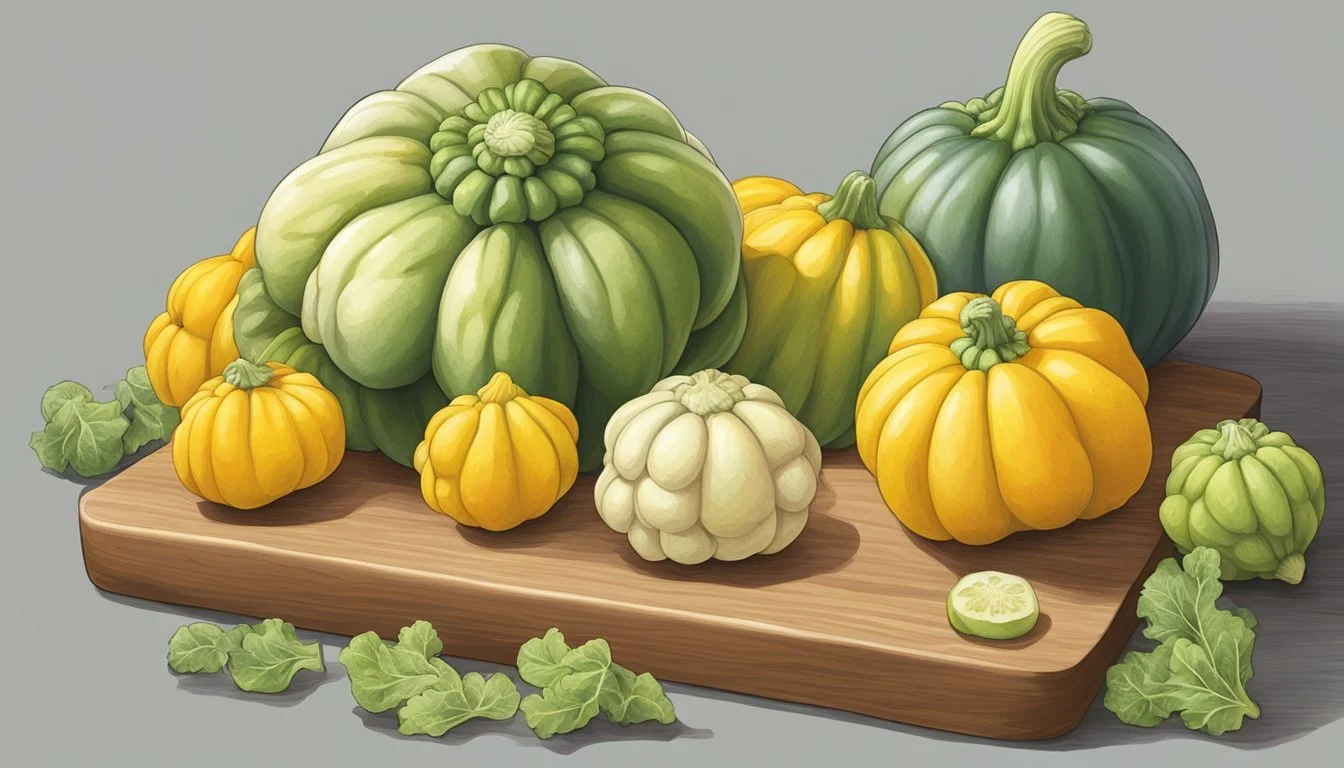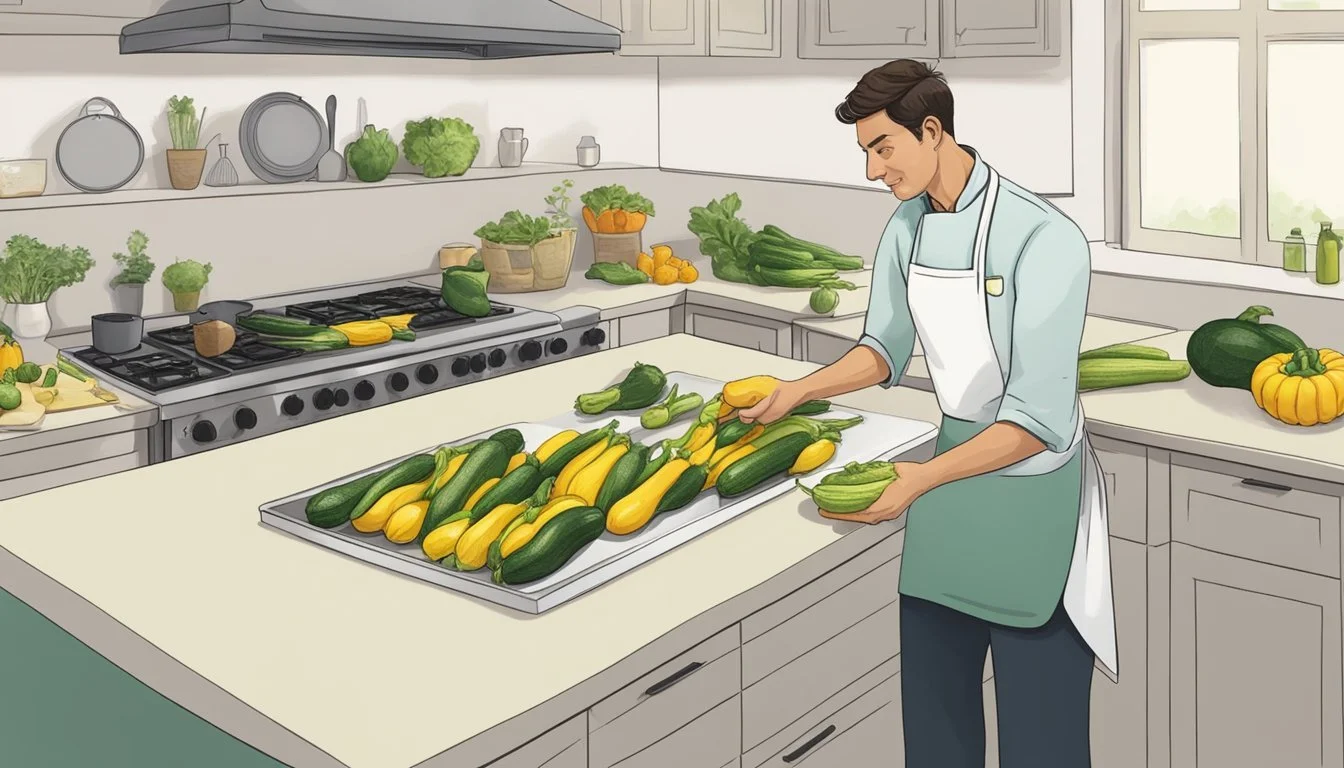Pattypan Squash Substitutes
Top Alternatives for Your Recipes
If you're looking for an alternative to pattypan squash, there are plenty of flavorful and versatile substitutes available. Zucchini is one of the best substitutes for pattypan squash due to its similar texture and mild taste. It seamlessly blends into a variety of dishes, making it a convenient swap in recipes that call for pattypan squash.
Another excellent substitute is yellow squash, which offers a comparable flavor profile and can be used in a wide range of cooking applications, from casseroles to stir-fries. Additionally, sweet potatoes provide a unique twist with their sweet flavor and starchy texture, making them suitable for hearty dishes like stews and soups.
Exploring these substitutes can not only fill the gap left by pattypan squash but also bring new flavors to your cooking. By incorporating ingredients like zucchini, yellow squash, and sweet potatoes into your recipes, you can maintain the desired texture and taste while enjoying the variety these vegetables bring to your culinary creations.
Understanding Pattypan Squash
Pattypan squash, also called scallop squash, is a summer vegetable noted for its unique shape, diverse colors, and beneficial nutritional profile. Below are the key characteristics and nutritional values essential for a comprehensive understanding of this versatile squash.
Characteristics of Pattypan Squash
Pattypan squash has a distinct, small, disc-like shape with scalloped edges, reminiscent of a toy top or flying saucer. It can be found in various colors including yellow, green, and white, offering a vibrant aesthetic to any dish.
The texture of pattypan squash is tender with a slight crunch, making it perfect for roasting, grilling, or sautéing. It has a subtle flavor, slightly nutty and sweet, which complements a variety of seasonings and ingredients.
This summer squash is typically harvested when it's small and tender, generally around 2-3 inches in diameter. Its versatility in cooking methods allows it to be stuffed, sliced, or even pureed for soups.
Nutritional Value
Pattypan squash is not only appealing in appearance but also packs a nutritional punch. It is low in calories, making it an excellent choice for those looking to maintain or lose weight.
Rich in vitamins such as Vitamin C and Vitamin A, pattypan squash supports the immune system and eye health. Additionally, it provides essential minerals like potassium and magnesium, which are crucial for heart health and muscle function.
This vegetable is also a good source of dietary fiber, aiding in digestion and promoting a healthy gut. Its antioxidant properties help combat oxidative stress, contributing to overall health and wellness.
Pattypan squash can be a valuable addition to a balanced diet, offering both flavor and nutrition without excess calories or fat. It's a stellar example of how delicious and nutritious summer vegetables can enhance your culinary repertoire.
Culinary Uses
Pattypan squash can be used in a variety of dishes and recipes, offering versatility in cooking methods. From roasting to grilling, it can be prepared in numerous ways to suit different tastes and preferences.
Common Recipes and Dishes
Pattypan squash is frequently included in roasted vegetable mixes and served as a side dish. When roasted, its natural sweetness deepens, making it a perfect complement to meats such as chicken and beef. Additionally, it is often stuffed with ingredients like rice, cheese, or ground meats, creating a robust and flavorful main course.
In baking recipes, pattypan squash can be used in casserole dishes, where its tender flesh absorbs the rich flavors of cream and cheese sauce. For lighter fare, consider slicing and sautéing it with garlic and herbs or grilling it to add a smoky flavor to summer salads.
Tips for Cooking and Baking
When preparing pattypan squash, start by washing it thoroughly. If the squash is large, it may need peeling, but younger, smaller squash can often be left with the skin on. For roasting, preheat the oven to 400°F. Cut the squash into halves or quarters, toss it with olive oil, salt, and pepper, and roast for about 20-25 minutes until tender.
For grilling, slice the squash into thick rounds, brush with oil, and grill for about 4-5 minutes on each side. If stuffing, scooping out the seeds creates space for fillings. Place the stuffed squash on a baking sheet and bake in a preheated oven at 350°F for 30 minutes, or until the filling is fully cooked and the squash is tender.
Selecting Substitutes
Choosing the right substitute for Pattypan squash depends largely on the dish being prepared and the desired texture and flavor.
Best Alternatives for Pattypan Squash
Zucchini: Zucchini offers a similar texture and flavor to Pattypan squash, making it a versatile substitute. It is widely available and can be used in most recipes that call for Pattypan squash, including stir-fries and sautéed dishes.
Acorn Squash: With its nutty and sweet flavors, acorn squash is a good alternative, especially in roasted or stuffed dishes. It has a creamy texture when cooked, which can lend a comforting taste to various recipes.
Butternut Squash: Butternut squash is another excellent substitute, especially for recipes requiring a denser texture. Its sweet, nutty flavor pairs well with both savory and sweet ingredients.
Yellow Squash and Crookneck Squash: These squashes are similar in texture to Pattypan. They can easily replicate the mild flavor and are suitable for a wide range of dishes, from casseroles to sautés.
Spaghetti Squash: Although different in texture, spaghetti squash can be a unique substitute when cooked and shredded. It works well in recipes where the squash needs to absorb sauces or other flavors.
When to Use Each Substitute
Zucchini: Use zucchini as a substitute in dishes where you need a soft texture and mild flavor. It's ideal for stir-fries, sautés, and casseroles.
Acorn Squash: Choose acorn squash for baked, roasted, or stuffed recipes. Its firmer texture and sweet, nutty flavor add depth to the dish.
Butternut Squash: Butternut squash should be used in soups, stews, and roasted vegetable dishes. Its creamy texture and sweet flavor make it a stands out in these applications.
Yellow Squash and Crookneck Squash: These substitutes are perfect for summer salads, quick sautés, and any recipe requiring a tender, mild squash. They can also be grilled or roasted.
Spaghetti Squash: This is best used in recipes where you want a light, strand-like texture that mimics pasta. It pairs well with tomato-based sauces and cheese.
Recipes Modification
When substituting for pattypan squash, it's important to consider both the flavors and textures involved, as well as the necessary adjustments in cooking techniques and times. The following sections provide detailed guidance on these aspects.
Adjusting Flavors and Textures
Each type of squash or vegetable brings unique flavors and textures. For example, zucchini has a mild taste and crunchy texture, making it versatile. Yellow squash has a slightly sweet, nutty flavor.
Acorn squash introduces a nuttier taste with a softer texture. Sweet potatoes, with their sweet and starchy profile, can be used in hearty dishes like soups and casseroles. When making substitutions, balancing these new flavors with appropriate seasonings and complementary ingredients ensures a cohesive dish.
Cooking Times and Techniques
Different substitutes may require varying cooking times. Spaghetti squash, for instance, should be baked until soft and then scraped out of its skin. Yellow squash should be sliced thinly and can be roasted or sautéed quickly.
Acorn squash often needs a longer roasting time to become tender. Sweet potatoes can be baked, boiled, or steamed, depending on the dish. Adjusting oven temperatures and being mindful of moisture content can prevent overcooking or undercooking. Utilizing correct techniques ensures that the substitute achieves the desired texture and enhances the overall dish.
Additional Ingredients for Enhancement
Enhancing pattypan squash dishes involves using specific herbs, spices, cheeses, and sauces. These additional ingredients can elevate the flavors, adding complexity and richness.
Herbs and Spices
Fresh herbs like parsley and basil complement the mild, nutty flavor of pattypan squash. Parsley adds a bright, slightly peppery note, while basil brings a sweet, aromatic flavor.
purerweijcoserwsklcgso
Salt, pepper, and olive oil are essential. Kosher salt and ground black pepper help to balance and enhance the squash's natural sweetness. Lemon juice can be added to introduce a hint of acidity, brightening the dish.
Garlic, either minced or roasted, pairs well with pattypan squash. Adding a pinch of cumin or paprika can bring a warm, earthy depth.
Cheeses and Sauces
Cheeses like parmesan and feta meld well with pattypan squash. Parmesan cheese adds a nutty, savory element, perfect for grating over roasted squash.
Feta cheese offers a tangy, creamy contrast when mixed into salads or stuffed into squash.
Sauces such as marinara can offer a robust tomato base, complementing the squash's texture and flavor. Drizzling a squash dish with a bit of olive oil infused with garlic can elevate a dish with minimal effort.
Combining these elements thoughtfully assures that the pattypan squash reaches its full culinary potential.
Health and Nutrition Considerations
When substituting pattypan squash, it's important to consider the nutritional profiles of the alternatives. Key factors include caloric content, macronutrient distribution, fiber, and vitamin content, particularly vitamin C.
Caloric and Macronutrient Comparisons
Pattypan squash is low in calories, with around 20 calories per 100 grams. It contains minimal fat and protein, focusing mostly on carbohydrates. Substitutes like zucchini have a comparable caloric content, also at approximately 20 calories per 100 grams.
Caloric content (per 100g):
Pattypan Squash: 20 calories
Zucchini: 20 calories
Spaghetti Squash: 31 calories
In terms of macronutrients, vegetables such as zucchini and spaghetti squash are similar. Both maintain low levels of fat and protein, with carbs being the predominant macronutrient.
Macronutrient profile (per 100g):
Pattypan Squash: 1g protein, 0.2g fat, 4g carbs
Zucchini: 1g protein, 0.3g fat, 3g carbs
Spaghetti Squash: 1g protein, 0.6g fat, 7g carbs
Dietary Fiber and Vitamins
Pattypan squash, like other summer squashes, is rich in dietary fiber, which aids digestion and helps maintain a healthy weight. It typically contains 1-2 grams of fiber per 100 grams. Zucchini and spaghetti squash offer similar fiber content, supporting digestive health and contributing to satiety.
Dietary fiber (per 100g):
Pattypan Squash: 1.1g
Zucchini: 1g
Spaghetti Squash: 1.5g
When it comes to vitamins, pattypan squash is a good source of vitamin C, providing about 20% of the daily recommended intake per 100 grams. Zucchini offers a similar amount, while spaghetti squash contains slightly less.
Vitamin C content (per 100g):
Pattypan Squash: 20 mg
Zucchini: 17 mg
Spaghetti Squash: 2.1 mg
These comparisons can help determine the best substitute based on nutritional needs and dietary preferences.
Food Preparation and Storage
To effectively substitute Pattypan squash, proper preparation and storage techniques are crucial. These steps ensure ingredients are ready for use and maintain their freshness.
Preparation Techniques Before Cooking
Start by washing all substitute vegetables thoroughly under cold water. For substitutes like yellow squash or acorn squash, cutting into thin rounds, cubes, or wedges is recommended. This ensures even cooking.
Baking: Arrange on a baking sheet, season with salt, pepper, and olive oil, and bake at 450ºF until tender.
Boiling: Bring a pot of water to a boil, add the cubed squash, and cook until fork-tender. Drain thoroughly.
Roasting: Use methods similar to baking. Place the cut squash on a baking sheet, drizzle with olive oil, and roast in the oven.
Sautéing: Heat a pan with a bit of oil, add the prepared squash, and cook over medium heat until softened.
Storing Leftovers and Raw Substitutes
To store leftover cooked squash, place it in airtight containers and refrigerate for up to 3-4 days. For raw substitutes like spaghetti squash or acorn squash, store them in a cool, dry place away from direct sunlight to maintain freshness.
Refrigeration: Store cut or peeled squash in ziplock bags or sealed containers. They can last up to 3 days.
Freezing: For longer storage, blanch cubed squash briefly in boiling water, cool in an ice bath, and freeze in single layers on a baking sheet before transferring to freezer bags. Frozen squash can be kept for up to 3 months.
Enhancing Shelf Life: Keeping raw substitutes like yellow squash in the crisper drawer of the refrigerator can extend their freshness by a few days longer than room temperature storage.
Proper food prep and storage are fundamental to making the most of Pattypan squash substitutes.







